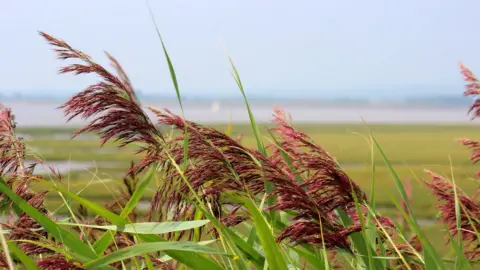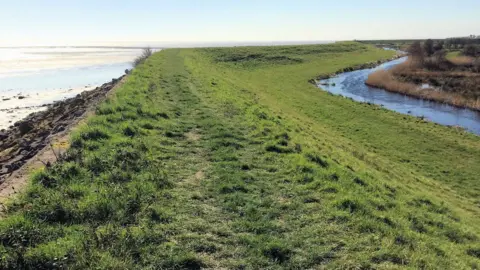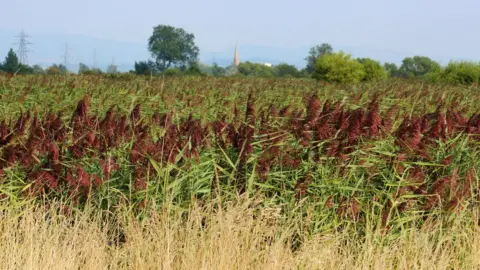Wildlife: Almost half of Wales' protected sites 'not monitored'
 Getty Images
Getty ImagesAlmost half of Wales' protected sites are not being monitored due to a lack of funds, RSPB Cymru has said.
A report found there was a lack of information on almost half of species and habitats of interest in Wales' protected sites.
RSPB Cymru said the nation was "haemorrhaging wildlife" due to repeated government budget cuts.
The Welsh government said an extra £12m would go on improving the condition and connectivity of protected sites.
Protected areas are designated sites of special scientific interest (SSSI) or Special Areas of Conservation (SAC) and Special Protection Areas (SPA) in order to safeguard Wales' most valued species and habitats.
The Natural Resources Wales (NRW) report said, where information is held, about 60% of protected areas were in an "unfavourable" condition.
However, the RSPB Cymru said the sites were considered unfavourable when they were not being managed effectively to protect their special wildlife.
 Getty Images
Getty ImagesKatie-Jo Luxton, the charity's director, said SSSIs should be the "premier league of places for nature in Wales".
She said: "Repeated budget cuts from Welsh government have resulted in Natural Resources Wales failing to deliver the management or monitoring needed and we are haemorrhaging wildlife as a result."
She added that the wildlife that calls them home "cannot survive and thrive if the sites are not in good condition".
The Gwent Levels are highlighted by the charity as an area where the lack of information could have an impact, putting ancient reens and ditches - which are home to rare aquatic plants and invertebrates - at risk.
Of the 60 SSSI feature condition assessments on this site, 70% are unknown, 17% are unfavourable and 13% are favourable.
The RSPB claim that while other UK countries have national monitoring programmes in place to regularly assess how well SSSIs are doing, in Wales this is the first national assessment that has happened since 2006.
The charity was also critical that the monitoring work was a "desk-based exercise", meaning that most of the judgements of how well individual sites and their features were doing were not informed by site visits.
Similar concerns were voiced by the WWF charity, with representative Alex Phillips describing the research as "shocking, yet sadly unsurprising".
He said that following the creation of the Welsh government climate ministry, "Wales cannot afford for these words not to be followed by the immediate action needed".
 Mike Waller
Mike WallerNRW said it "fully accepts that there are limitations" to the extent of their evidence adding that it's committed to "invest in, and support others to make improvements".
It's calling for an "all-Wales partnership approach" in the quest to reverse the decline in biodiversity.
NRW published the results of its protected sites baseline evaluation review as part of work to improve the evidence base.
Protected sites account for about 12% of Wales' surface area and NRW has an obligation to monitor 361 of the total of 4,117 sites.
As this could not be achieved using NRW resources alone, it's calling for the development of "innovative and more collaborative" monitoring programmes.
Ruth Jenkins, NRW's head of natural resource, said the action needed would build on existing projects but would also "crucially draw in the knowledge and invaluable expertise" of its partners and people living and working in special sites.


Alarm bells have been ringing loudly in recent years about the rate at which Wales is losing its wildlife.
From iconic birds like lapwing and curlew, mammals like the water vole to insects like the Marsh Fritillary butterfly and Snowdon leaf beetle.
All could soon be gone.
In fact, a major study in 2019 by over 70 environmental organisations suggested one in six of the species they looked at were at risk of extinction from Wales.
Effectively managing, improving and increasing the habitats they rely on is key to reversing the decline - which is why conservationists are so worried by the findings of this latest research by NRW.
And it matters for all of us - alongside climate change, scientists have warned that the "nature crisis" poses an existential threat for our own civilizations too.

Meanwhile Ian Dunn, CEO of Plantlife, said NRW's findings were "of deep concern" and that his charity welcomed their call for "government, communities and conservation charities to work together to safeguard these bright jewels in our biodiversity crown".
He said the national network of SSSIs provided a "lifeline" to some of Wales' most rare and threatened habitats and species such as the Snowdon lily and fen orchid.
 Getty Images
Getty ImagesA Welsh government spokesperson said it welcomed NRW's proposed approach "working with a range of stakeholders including RSPB to develop a new innovative monitoring programme".
"The report highlights the scale of task we all have in Wales to ensure our protected sites are restored to enable wildlife to thrive whilst delivering the many benefits."
It said it would also use the findings to "inform the development and implementation of a multi-year programme" which would recognise sustained management and monitoring in reversing the decline of biodiversity.
